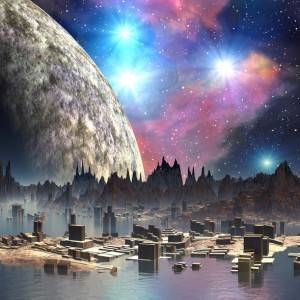
On Research, Rabbit Holes, and Sci-Fi Worldbuilding
This is a guest post from Erica O’Rourke. Erica has worked in a variety of jobs — library cataloger, barista, Girl Friday, English teacher, and stay-at-home mom — but she’s always been a writer, which explains (partially) why her math grades were so abysmal.
Her debut novel, Torn, won the Romance Writers of America’s 2010 Golden Heart Award for Best Young Adult Manuscript, and was the launch title for Kensington Books’ KTeen imprint. The Torn Trilogy also includes Tangled and Bound (available now). Her latest series, Dissonance, is about a girl with the ability to walk between alternate realities, who falls for different versions of the same boy in every world she visits. A companion e-novella, Harmonic, is also available. The sequel, Resonance, was published July 22 by Simon and Schuster.
When Erica is not writing, she’s reading. And when she’s not reading, she’s probably watching Doctor Who, cooking, or spending time with her husband and three daughters just outside of Chicago. Follow her on Twitter @erica_orourke.
____________________
Confession: I never took high school physics. Or college physics. Eighty-five percent of my scientific knowledge comes from old episodes of Bill Nye the Science Guy and the sci-fi novels I read growing up. Which meant when I decided to write a book based on multiverse theory, I quickly realized I was out of my depth.
The temptation to just “make it up” was strong. But science fiction and fantasy readers are smart. No matter how outlandish your premise, readers expect an internally consistent world. If your characters live on a zero-gravity planet, for example, it’s easy to remember that walking will look different. But so will having a bowl of soup, wearing a skirt, or shoving someone off a cliff. The rules need to apply consistently in every single scene. (And if they don’t apply in a particular instance, there should be a compelling reason why.)
Readers also crave immersion. They want to inhabit a richly detailed world, one with depth and history. In science fiction and fantasy, the setting is practically another character, and knowing the backstory of your world is equally important, even if only some of that knowledge makes it onto the page.
Research helps with both consistency and authenticity. In the case of Dissonance, I knew just enough about multiverse theory to be a danger to myself. The initial premise – every choice creates two different worlds – was simple enough. But my heroine would be moving between worlds, which meant I needed to clearly explain the structure of the multiverse, and create plausible, ironclad rules for navigating it.
My research followed a three-step process: gathering, specializing, pruning. This allowed me to learn about my topics efficiently, and use them to strengthen and enrich the story without overwhelming it.
Step One: Hunting and Gathering
My research typically begins with amassing general knowledge: Wikipedia, accessible non-fiction, textbooks. Getting a feel for the subject allows you to avoid obvious errors and lets me get the bigger pieces of my worldbuilding in place early on. For example, according to the many-worlds theory, the multiverse is mindbogglingly big and growing exponentially. I used that growth as an explanation for why Walkers must cleave worlds, giving their motivation a sense of urgency.
As you’re researching, take note of the topics that seem particularly interesting or relevant. You’re going to need them in step two…
Step Two: Find Some Rabbit Holes
Once I had a working knowledge of my topics, I could start to shape my world, and decide which areas I wanted to learn more about. It’s easy to fall down the rabbit hole of research — one article leads to another, and another, and three hours later, you’re an expert on medieval hangover remedies even though you’re writing a space opera. The trick is to make these rabbit holes work for you. Dig into the areas that piqued your interest during step one, and look for ways to incorporate what you learn. Deeper investigations are great for establishing the vocabulary and texture of your world, the smaller pieces of worldbuilding that make it feel real.
In Dissonance, my research into perfect pitch uncovered connections to genetics, memory, dementia, and hearing loss. Those connections gave me a cohesive scientific explanation for why and how Walkers could navigate between worlds, and inspired the idea of “frequency poisoning,” a made-up illness that added layers of conflict and urgency to the story.
Where do you get this specialized information? I found NPR.org invaluable for easy-to-understand, slightly off-beat articles. Targeted Googling will turn up fascinating research abstracts, as well as blog posts for first-person perspectives. And interviewing experts is invaluable — not just to learn their thoughts, but also how they speak. Those kind of details are the difference between an authentic voice and a cardboard cutout.
Step Three: Winnow Down The Details
By the time I was done researching, I was desperate to show off my knowledge. Every time my editor asked a question about worldbuilding, I answered by adding another layer of scientifically valid complexity. The problem was, the story was threatening to collapse under the weight of so many detailed explanations.
It was time to simplify. I went through my manuscript and cut anything the reader didn’t absolutely need to know. I reminded myself that I was writing science fiction, so it was okay to take liberties when needed. Worldbuilding needs be plausible, but it also needs to serve the story. Themes, characters, conflict, action…they should benefit from the world you’ve created, not get lost in it, so choose your details carefully.
Research is the key to creating a rich, consistent science fiction world – but don’t be afraid to use it selectively. After all, what’s the fun of creating entire worlds if you can’t be the boss of them?

















